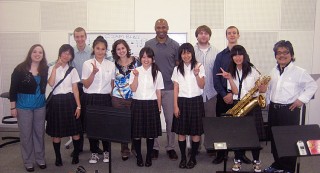Title

Jazz faculty member Ron Blake (center) with members of the Juilliard Jazz Orchestra and students from Osaka, Japan.
At 7 a.m. sharp on August 3, the Juilliard Jazz Orchestra began a 9,000-mile trip from 65th Street in Manhattan to Osaka, Japan. Over the next five days, the Jazz Orchestra and the Juilliard Jazz All-Stars got the chance to conduct a series of workshops and performances for high school and college students at Osaka University of the Arts. The collaboration between Osaka University and The Juilliard School has been in development over the last three years thanks to the efforts of Carl Allen, Juilliard Jazz artistic director, and Laurie Carter, the program’s executive director. Last March marked the first official exchange between the schools when Osaka University sent 15 students, administrative staff, and faculty to work with Juilliard Jazz students and faculty in New York City. To continue the relationship, the members of the Juilliard Jazz Orchestra headed for Japan to share their knowledge and music with the city of Osaka.
Body
After an entire day of travel to the other side of the world, the group started day two with an interesting cultural experience. Still in a fog from the 13-hour time difference, some members wandered into a traditional Japanese restaurant where breakfast consisted of rice, miso soup, egg, salmon sushi, and fish cakes. They had no idea the intended place for our meal tickets was next door to the hotel where a surprisingly great American breakfast was served. Most of us weren’t ready to venture out and dive into raw fish first thing in the morning. We stuck with what we knew best: Texas toast, scrambled eggs, ham, and orange juice.
Full from a hearty breakfast, we took a scenic bus ride to Osaka University where the first workshops served as an icebreaker for interaction between the Jazz Orchestra and two talented high school bands from Osaka. The local students spoke little—if any—English, placing all initial communication responsibilities on the translators provided by the university. In addition to the language barrier, it was early in the morning. Just like American high school students, Japanese students seemed to be having a hard time functioning before noon! To get things started, we decided to wake them up with a lively version of Don Menza’s Groovin’ Hard, featuring a hard swinging solo by special guest saxophonist and Juilliard faculty member Ron Blake. Despite the high energy of our performance, the students still needed something more to clear the morning cobwebs. Rather then push them to ask questions following our performance, we asked them to perform for us. We had no idea the students’ performances would create the excitement and momentum we needed to get the workshops rolling so we could start making great music.
The first ensemble up was a full jazz band that pulled out a high-energy arrangement of Rochester, N.Y., native Chuck Mangione’s composition Feels So Good. This was the last piece of music we expected to hear from a band on the other side of the world. They grooved, played their parts confidently, and did it all from memory. The work ethic this group possessed helped us immensely when it came time to work with the students in the master classes. As much as we enjoyed the performance of Feels So Good, the next high school to play held a special place in the hearts of Juilliard Jazz Orchestra members. Only about 10 strong, the group performed a stirring rendition of a tune called We Love Osaka! The song was a march with a few loud chants, in English, of “We Love Osaka!” The energy of the performance was so inspiring, Professor Allen jumped out of his seat and hopped on the drum set for an encore.
The bulk of our time at the university was spent working with groups based on specific instruments. The basics of practicing, playing in the big band setting, and improvising were explored. The once shy students began to open up to us and information was flowing from the Jazz Orchestra members, through the translators, to the students as if we spoke the same language. By the end of the week, we felt like celebrities as the students requested autographs and cell phone camera shots with us.
For me, the most satisfying part of this whole workshop experience was watching the reactions of the Juilliard Jazz Orchestra and faculty during the students’ final performance at Osaka University. Smiles and laughs were flying everywhere. We had made a connection with the students and it was rewarding to see their progress. The comfort level of the students was apparent as well, and it showed in their music. We were all speaking a universal language—the language of music. If all goes as planned, this will be a relationship between universities that will continue for many years to come.




